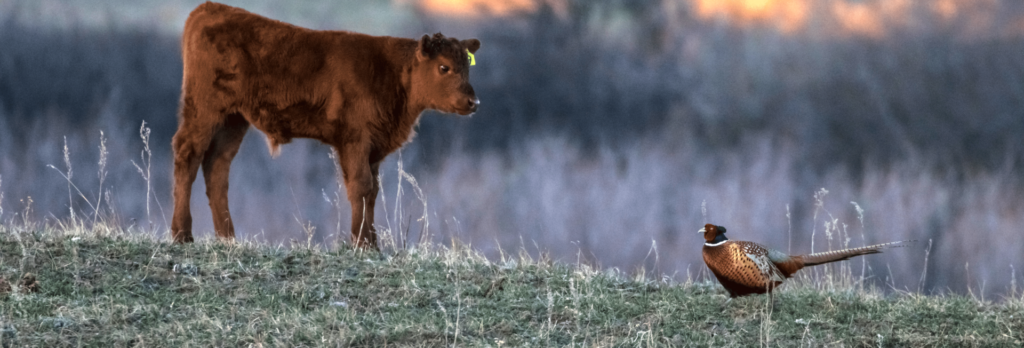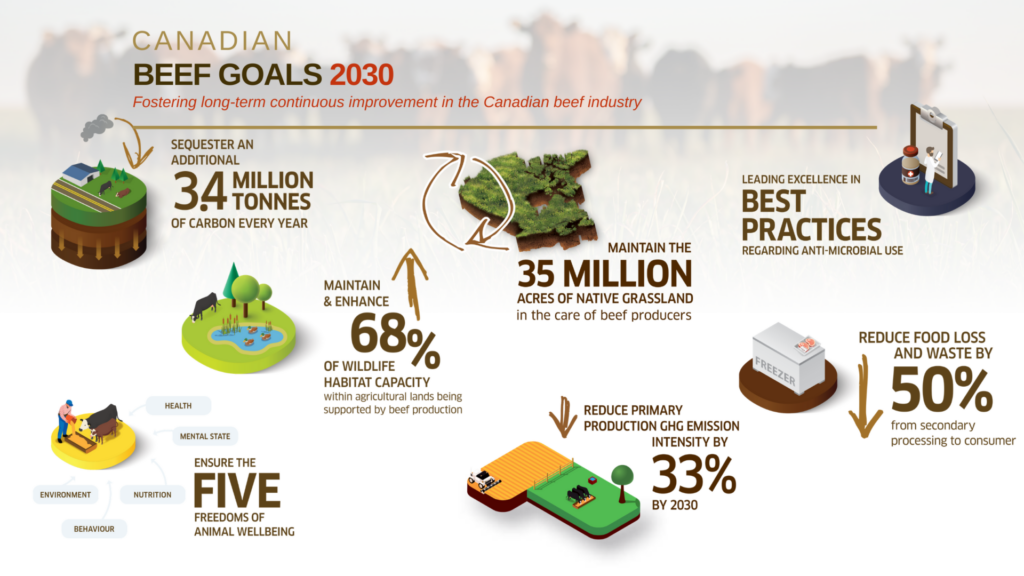AB Direct - Steers
Rail: ---
AB Direct - Heifers
Rail: ---
US Trade- Steers
Rail: 495.00 del
US Trade - Heifers
Rail: 495.00 del
Canadian Dollar
0.06

Science confirms the beef industry’s environmental benefits
Canadian beef producers continue to make significant progress in making their operations more environmentally sustainable thanks in part to research and extension efforts.
“We’ve done a lot of work to quantify how beef producers are reducing their environmental footprint,” Dr. Kim Ominski says, citing results showing lower greenhouse gas emissions, water use and ammonia emissions per kilogram of beef produced. Ominski is a professor in the University of Manitoba’s Animal Science Department and this year’s recipient of the Canadian Beef Industry Award for Outstanding Research and Innovation.

She says improvements have occurred in animal productivity (reproductive efficiency, weaning weight, carcass weight) and crop yields (barley grain, barley silage, corn grain and corn silage). Improving productivity allows more beef to be produced from fewer cattle, less feed, land and water, and reduces emissions per kilogram of beef.
In a study she and her colleagues published in 2015, they found that in 2011, Canadian beef production needed only 71 percent of the breeding herd and 76 percent of the land needed to produce the same amount of liveweight for slaughter as in 1981. At the same time, for each kilogram of beef, Canadian cattle producers have:
- reduced GHG emissions by 15 percent,
- lowered water use by 17 percent and
- decreased ammonia emissions by 20 percent.
Ominski also says that the land producers need to raise their cattle is incredibly important in terms of carbon sequestration. Forages and grasslands used for grazing capture carbon dioxide (CO2) from the atmosphere, carbon above the ground in plant growth and carbon below the ground in roots.
“These landscapes play a critical role in maintaining carbon stocks and biodiversity. Not only are they important for cattle but they also provide habitat for many plant and animal species including wildlife,” she says.
View from the ranch
Ryan Beierbach agrees.
“You look at things like wildlife – producers are more willing to provide habitat now, even if it costs them a bit,” says Beierbach. He, his wife Tania and his family run 750 cattle and own a ranch supply and tack store near Whitewood, Saskatchewan. Beierbach is the current chair of the Canadian Roundtable for Sustainable Beef and past chair of the Beef Cattle Research Council.

Producer attitudes toward the environment are the biggest changes he has witnessed over the past quarter century in Canada’s beef industry.
Part of the reasoning is that producers are proud of the fact that they are the guardians of the environment, and another part is that governments have come on board with programs to help producers offset some of the financial costs.
There’s also the role of research and the fact that producers now have a better understanding of how grass grows and how to manage it.
“We understand more about soil and microbes and how the cattle interact with it, along with the land’s ability to sequester carbon,” he says, adding that this also improves production so ranchers can graze more cattle while managing to help the overall system become more resistant to drought.
He says ranchers have always wanted to leave the land better for the next generation, but now they are more aware of what is going on with the environment and how they can make it more resilient.

He credits the Beef Cattle Research Council (BCRC) and particularly its more recent focus on extension – bringing practical research results and solid production advice to ranchers – for the improvements.
“Government largely got out of the extension business, and BCRC has had more money to spend in the last few years since the increase in the Canadian Beef Cattle Check-Off,” he says. “With that, we can do the research and provide the extension work – it’s made a big difference in getting producers to understand more about rotational grazing and things like water quality.”
On his own ranch, he has been using rotational grazing for 15 years – moving the cattle every two to four days in the spring and every three to five or six days in the fall. He has also installed solar troughs and water pipelines.
Before he put his pipeline in, cattle would have to walk a mile and a half for water through multiple fields which meant they were grazed more than they should be and for longer periods than they should. Using solar troughs near dugouts has meant the dugouts don’t dry out as much as they used to.
“Three summers ago, we had a long period of drought and most other dugouts were dry – and I barely got through the grazing season thanks to the solar water troughs,” he says.
Twenty-one years ago, when Beierbach bought his ranch, it was marginal farmland and he continuously grazed his cattle for the first five years. As a result of rotational grazing and other methods Beierbach has used since then, he has noticed that there are more willow trees – which provide good shelter for the cattle to get out of the wind, and habitat for birds and deer.
Getting the message out
Ominski points out that many by-products of the food processing sector – which might otherwise be sent to the landfill and create their own greenhouse gases – are used by the livestock industry to create high quality protein.
“We have the largest pea processing facility in the world here in Manitoba, and the co-products that come out of it have a perfect place in the feed market for ruminants, which can take these highly fibrous products and convert them to milk and meat,” she says.
Ominski is a strong advocate for providing consumers solid information about the environmental impacts of the beef industry and producers.
“What’s important is that beef production requires fewer resources – in terms of land and water, but it also means lower emissions per unit of meat produced,” she says.
Not only are sustainability metrics difficult to measure but they are also equally difficult to communicate to the general public. She sees the scientists’ role as generating science-based information and having conversations with consumers so that they can make food choices that are right for them.
“This information is also important for producers – it empowers them to show the changes that they’ve made and how they’re producing more food with fewer resources,” she says.
Research is also really important to generate solid science to inform government program and policy development, Ominski adds. Because of the complexity of the beef production system, researchers must work with producers to develop effective best management practices that are practical and cost-effective.
Charting the future
The Canadian beef industry has set ambitious environmental targets for 2030.
A number of organizations, including the Canadian Roundtable for Sustainable Beef, the Canadian Cattle Association and the BCRC have developed a series of 10 industry-specific goals, including reducing greenhouse gas emission intensity by 33 percent and increasing carbon sequestration by 3.4 million tons per year. They’ve also set goals of maintaining the 35 million acres of grassland currently used by beef producers and maintaining and enhancing 68 percent of wildlife habitat capacity.
Getting there will require a collaborative effort – which Ominski emphasizes often.
“There’s no silver bullet – improvements are coming from many different places – selecting and managing animals for improved production and reproduction, improving the quality of forages, and changes in land management practices to preserve perennial forage land,” she says.
“To achieve those goals, we have to work together at many different levels to develop best management practices, as well as program and policies to ensure the environmental and economic sustainability of our food systems.”

This article was originally posted on the Beef Cattle Research Council’s website on December 11, 2023.


